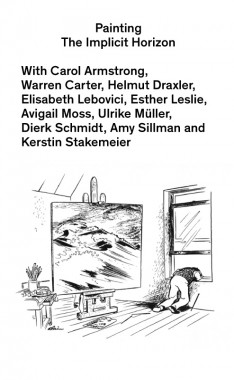
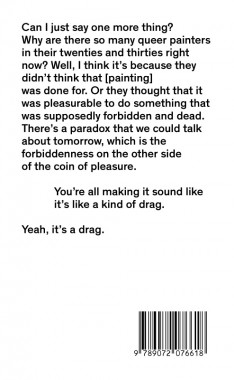
Avigail Moss and Kerstin Stakemeier, Painting — The Implicit Horizon
Softcover, 192 pp., offset 1/1, 110 x 140 mm
Edition of 500
ISBN 978-90-72076-61-8
Published by Jan van Eyck Academie
$11.00 · out of stock
Painting — The Implicit Horizon documents a symposium which took place at the Jan van Eyck Academie in Maastricht, the Netherlands. The book presents essays and transcripts of discussions between European and American artists, art historians, and critics who have looked at some of the ways painting has been conceived of in the eras after Conceptual Art. Addressing ideas of production and consumption, critiques of the end of art, issues of age, accomplishment, and the myth of the painter, the book posits that painting, as a working practice as well as a historical referent, serves as an implicit horizon or limit condition for other media.
“Jimson lives in a ramshackle houseboat on the Thames river, where he reminisces about the days when the state collected his paintings, hides from the police (who pursue him for his minor infractions and debts) and schemes about how to extract money from various wealthy patrons. That is, his struggles are conceptual, material and financial and always involve a race against time and an acknowledgement of his own limitations even in light of his successes. After a series of roguish scrapes, he finally receives a retrospective at Tate Britain: a triumph that does little to alleviate his destitution. But the film’s dénouement comes when Jimson paints a “monument to England”: a giant mural representing “The last Judgment” on the side of a bombed-out church aided by a cadre of voluntary art student assistants who he keeps remunerated in cups of coffee. The film ends when Jimson — threatened by council developers looking to capitalize on the land — voluntarily bulldozes his mural in advance of the city bureaucrats and sails off down the Thames in search of a new horizon: perhaps another, larger wall (or a further expansion of painting as such).”
CONTRIBUTORS
Carol Armstrong, Warren Carter, Helmut Draxler, Kerstin Stakemeier, Elisabeth Lebovici, Esther Leslie, Avigail Moss, Ulrike Müller, Dierk Schmidt, and Amy Sillman.
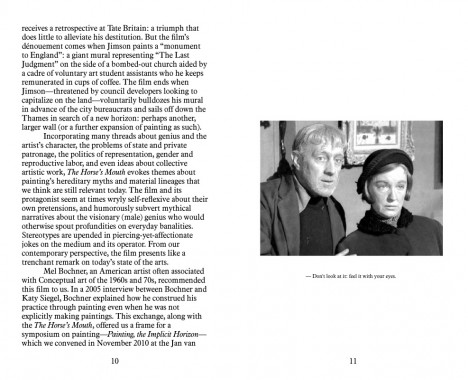
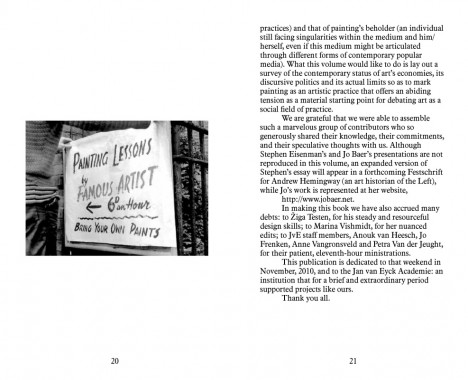
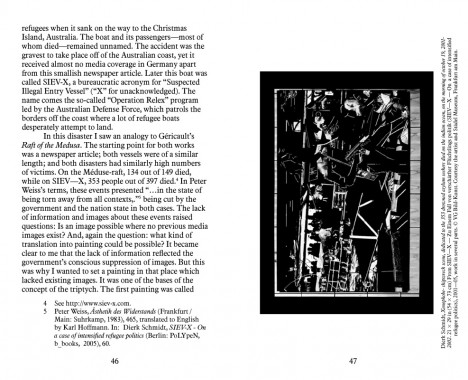
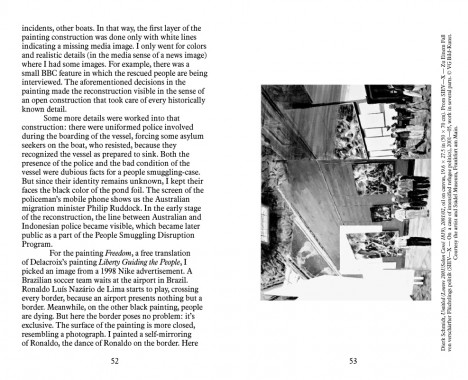
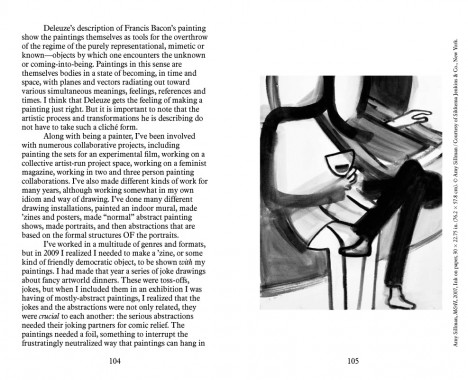
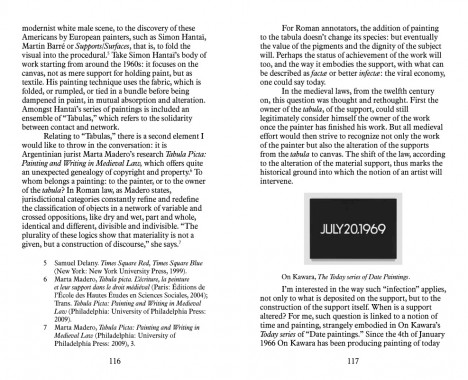
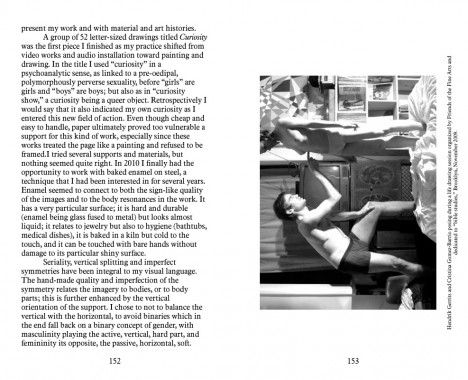
Alan Smart, Amy Sillman, Annet Perry-Schoot, Anouk van Heesch, Art, Avigail Moss, Carol Armstrong, Criticism, Culture, Daniel Brustlein, Dierk Schmidt, Distribution, Elisabeth Lebovici, Esther Leslie, Fox Hysen, Gully Jimson, Helmut Draxler, Jan van Eyck Academie, Jo Baer, John Bratby, Katja Diefenbach, Kerstin Stakemeier, Marina Vishmidt, Minika Baer, Painting, Ronald Neame, Sir Alec Guinness, Stephen Eisenman, Theory, Ulrike Müller, Warren Carter, Žiga Testen
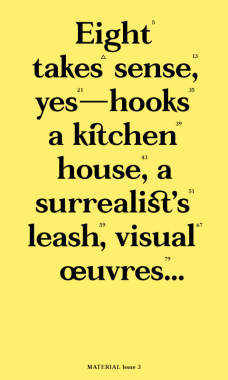
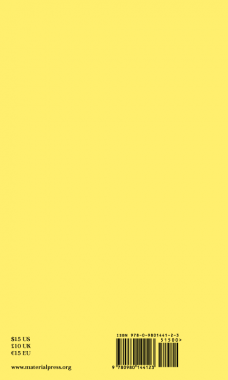
Ginny Cook and Kim Schoen, MATERIAL 3
Softcover, 96 pp. + insert, offset 2/1, 160 x 270 mm
Edition of 500
ISBN 978-0-9801441-2-3
Published by MATERIAL Press
$15.00 ·
MATERIAL exists as a platform for the artist’s voice. Each issue brings together a different group of artists who write, as well as a new collaboration with a graphic designer. During the production of this third issue, our designer Zak Jensen put forth the idea of concatenation — the act of linking together, or the state of being joined (
It was caused by an improbable concatenation of circumstances) (there was a connection between eating that pickle and having that nightmare)
(the joining of hands around the table).
Concatenation (c.1600, from L.L. concatenatus, pp. of concatenare “to link together,” from com- “together”+ catenare, from catena “a chain”) seemed an appropriate word for our editorial method. An unlikely assemblage of texts becomes connected through this process; uncanny linkages emerge. Wyeth appears twice. Performances interact. In this issue: voices that duel, voices that parrot, voices that hypothesize, translate, and meditate, voices that speak simultaneously. As Roland Barthes writes, we have assembled these textual events, as “pleasure in pieces; language in pieces; culture in pieces,” to build upon one another into something new.*
*Roland Barthes, The Pleasure of the Text, trans. Richard Miller (New York: Hill and Wang, 1975), p. 51
CONTRIBUTORS
Farrah Karapetian, Paul Zelevansky, Renee Petropoulous, Nate Harrison, James Welling, Natalie Häusler, Harold Abramowitz, Shana Lutker Stephanie Taylor, Alice Könitz, Frank Chang, and Emily Mast.
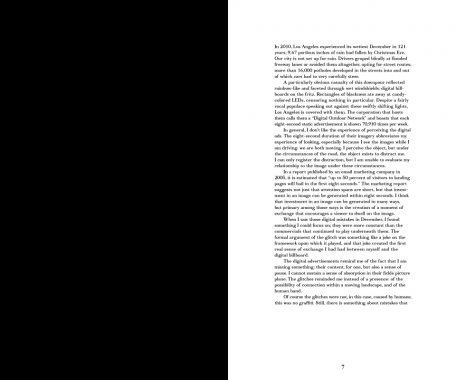
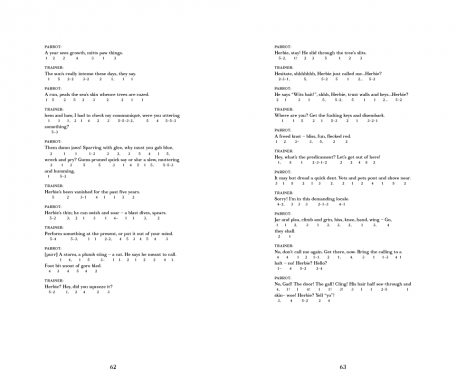
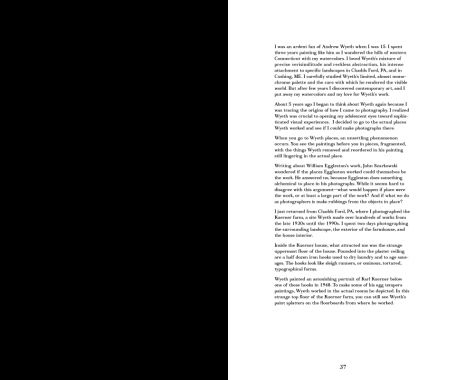
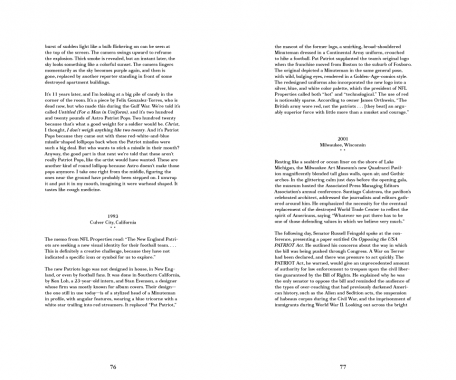
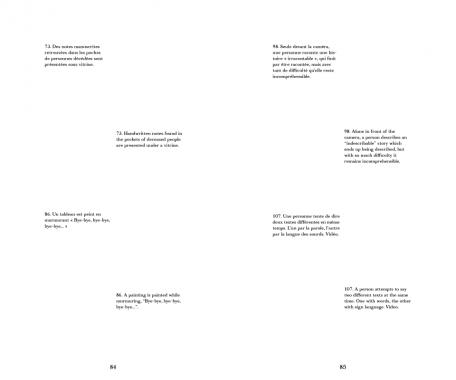
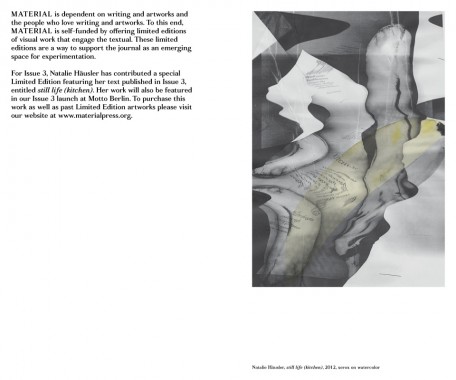
Alice Konitz, Andrew Wyeth, Art, Catherine Guiral, Concatenare, Criticism, Daniel Lucas, Design, Distribution, Dorit Cypis, Emily Mast, Farrah Karapetian, Frank Chang, Ginny Cook, Harold Abramowitz, James Welling, John Stezaker, Jonathan Miles, Kim Schoen, MATERIAL Press, Natalie Häusler, Nate Harrison, Olivier Richon, Paul Zelevansky, Quentin Walesch, Renee Petropoulous, Richard Miller, Roland Barthes, Shana Lutker, Stephanie Taylor, Theory, Thomas Lawson, Typecraft Wood & Jones, Typography, Wendy Schoen, Zak Jensen
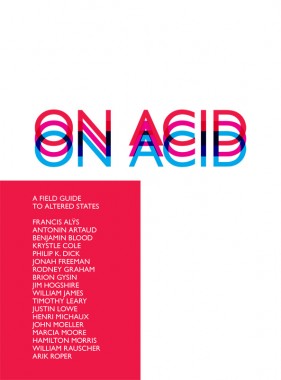
William Rauscher and John Moeller, On Acid
A Field Guide to Altered States
Softcover, 100 pp., offset 4/3, 200 x 265 mm
Edition of 1000
ISBN 978-0-615-53398-8
Published by CCC
$15.00 ·
On Acid presents a radically subjective re-edit of the history of drug experience, following the emergence of drugs as a technology and modernity’s conflicted obsessions with altered states. Tracing a path beginning with philosopher Benjamin Blood’s 1874 pamphlet ‘The Anesthetic Revelation and the Gist of Philosophy’ which declares the existence of a ‘majesty and supremacy unspeakable’ observable only after being dosed by nitrous oxide,
On Acid assembles texts and images that draw a line connecting archival works by William James, Antonin Artaud, Timothy Leary, and various modernist explorers, to the practice of contemporary artists such as Rodney Graham, Francis Alÿs, Jonah Freeman and Justin Lowe. Removed from the familiar cultural contexts of Haight-Ashbury and Grateful Dead psychedelia,
On Acid is in itself an experimental program, a recursive acidic process that mirrors the deconstructive relations to counterculture cultivated in contemporary art. The book concludes with a series of new conversations with Freeman and Lowe, Hamilton Morris and Arik Roper.
TEXTS
Francis Alys, Antonin Artaud, Benjamin Blood, Philip K. Dick, Rodney Graham, Brion Gysin, Dr. Albert Hofmann, Jim Hogshire, Aldous Huxley, International Federation for Internal Freedom, William James, Timothy Leary, Marcia Moore, William Rauscher, Alan Watts.
IMAGES
Brian Aldiss, Francis Alys, Carol Bove, Syd Barrett, Mathieu Briand, Krystle Cole, Jonah Freeman and Justin Lowe, Allen Ginsberg, John Giorno, Rodney Graham, Brion Gysin, Carsten Holler, Henri Michaux, John Moeller, Arik Roper, Sandoz Laboratories, Ettore Sottsass, Klaus Weber.
INTERVIEWS
Justin Lowe and Jonah Freeman, Hamilton Morris, Arik Roper.
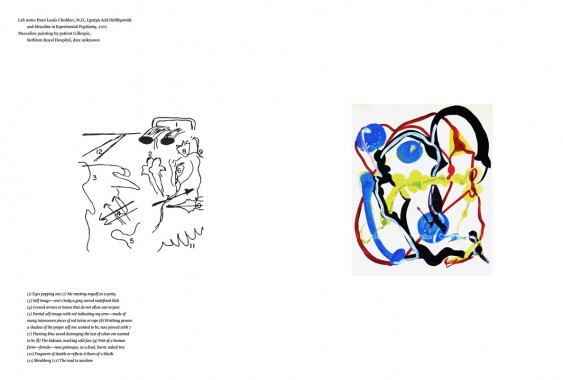
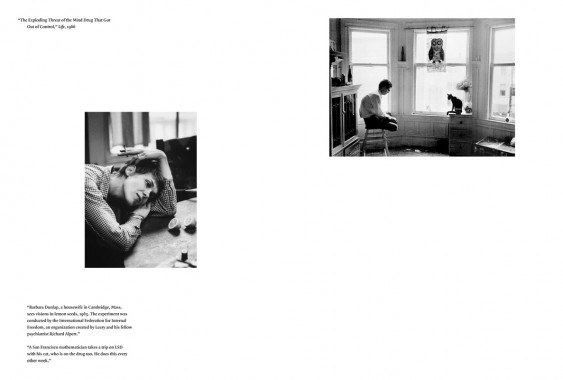
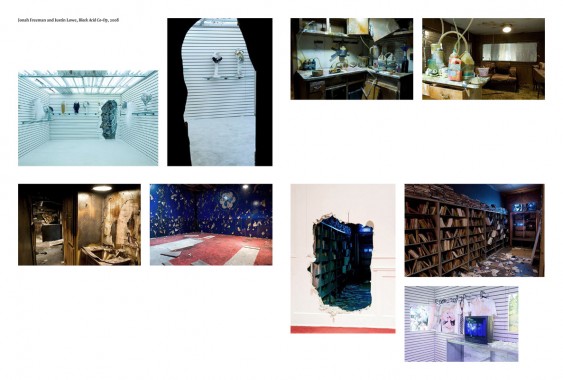
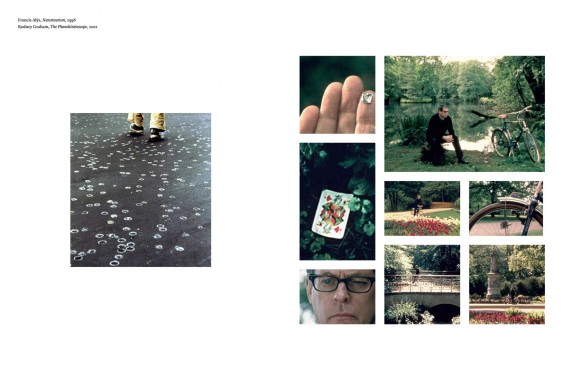
Alan Watts, Aldous Huxley, Allen Ginsberg, Antonin Artaud, Arik Roper, Art, Benjamin Blood, Brian Aldiss, Brion Gysin, Carol Bove, Carsten Höller, CCC, Criticism, Culture, Distribution, Dr. Albert Hofmann, Ettore Sottsass, Francis Alys, Hamilton Morris, Henri Michaux, International Federation for Internal Freedom, Jim Hogshire, John Giorno, John Moeller, Jonah Freeman, Justin Lowe, Klaus Weber, Krystle Cole, Marcia Moore, Mathieu Briand, Philip K Dick, Philosophy, Psychedelia, Rodney Graham, Sandoz Laboratories, Syd Barrett, Theory, Timothy Leary, William James, William Rauscher
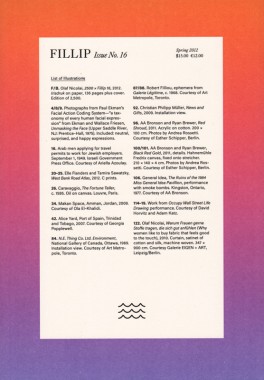
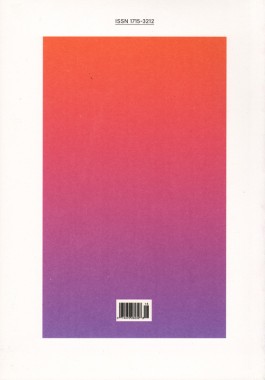
fillip 16
Softcover, 136 pp., offset [split fountain], 170 x 245 mm
Softcover, 32 pp., offset 1/1, 140 x 210 mm [Ariella Azoulay booklet]
Edition of 2500
ISSN 1715-3212
ISBN 978-0-9868326-6-6
ISBN 979-0-9868326-8-0 [Ariella Azoulay booklet]
Published by Fillip
$15.00 ·
Fillip is a publication of art, culture, and ideas released three times a year.
Fillip 16 continues the ongoing series of texts entitled Apparatus, Capture, Trace, and includes a booklet by Ariella Azoulay, Different Ways Not to Say Deportation.
The issue also continues essays from the Intangible Economies series, and focuses on the multifarious forms of exchange fueled by affect and desire. Intangible Economies speculatively investigates the fundamental role these affective transactions play in modes of representation and, accordingly, in cultural production.
1. Patricia Reed, Co-autonomous Ethics and the Production of Misunderstanding
2. Ola El-Khalidi and Diala Khasawnih, Gastronomica Makan
3. Christopher Cozier and Clair Tancons, No More than a Backyard on a Small Island
4. Vincent Bonin, Here, Bad News Always Arrives Too Late
5. Jon Davies, The Masculine Mystique
6. Philip Monk, Crises (and Coping) in the Work of General Idea
7. David Horvitz and Adam Katz, Occupy Wall Street Life Drawing
AA Bronson, Adam Katz, Alice Yard, Andrea Rossetti, Antonia Hirsch, Ariella Azoulay, Art, Christian Phillip Muller, Christopher Cozier, Clair Tancons, Criticism, David Horvitz, Diala Khasawnih, Distribution, Elle Flanders, Esther Schipper, Fillip, General Idea, Georgia Popplewell, Jon Davies, Kate Steinmann, Kristina Lee Podesva, Ola El-Khalidi, Olaf Nicolai, Patricia Reed, Paul Ekman, Philip Monk, Robert Filliou, Ryan Brewer, Tamira Sawatzky, Theory, Vincent Bonin, Wallace Friesen
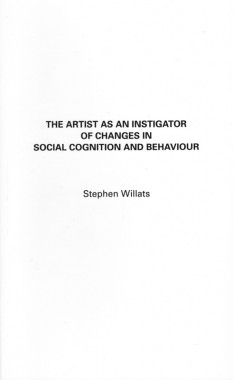
Stephen Willats, The Artist as an Instigator of Changes in Social Cognition and Behaviour
Softcover, 96 pp., offset 2/1, 130 x 210 mm
Edition of 1000
ISBN 978-0-9562605-6-7
Published by Occasional Papers
$18.00 · out of stock
Stephen Willats’ major essay The Artist as an Instigator of Changes in Social Cognition and Behaviour is re-issued for the first time by Occasional Papers. Published in 1973 by Gallery House, London — where Willats was Director of the Centre for Behavioural Art — and long out of print, the paper includes rigorous analyses of social forms of artistic production and descriptions of a number of projects by the artist.
Art, Centre for Behavioural Art, Criticism, Culture, Distribution, Gallery House, Occasional Papers, Stephen Willats, Theory
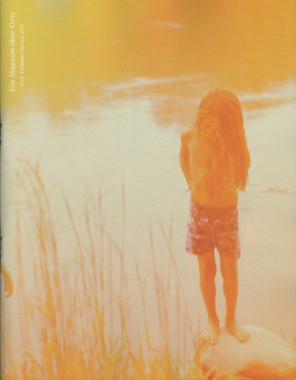
Ein Magazin über Orte 8, Paradise
Softcover, 84 pp., offset 4/4, 210 x 270 mm
Edition of 1000
ISSN 1866-2331
Published by Ein Magazin über Orte
$18.00 ·
Ein Magazin über Orte (A magazine about places) is published twice a year. It deals with a different location in every issue. The magazine collects works of various authors in the form of photographs, drawings and texts.
Agi Mishol, Art, Bela Pablo Janssen, Birgit Vogel, Brian Currid, Bruno Kurru, Bushra Rehman, Criticism, Culture, David Weiss, Distribution, Ein Magazin über Orte, Elmar Bambach, Gunter Kunert, Hans Magnus Enzensberger, Ibrahim Samuel, Jana Gontscharuk, Jeff Wall, John Copeland, Julia Marquardt, Kevin Coyne, Lidwien Van De Ven, Luc Tuymans, Marc Hieronimus, Marcus Oakley, Mark Borthwick, Michael Borremans, Mike Pare, Miranda July, Noor Damen, Peter Fischli, Photography, Raymond Meeks, Raymond Pettibon, Ryan McGinley, Theory, Wilhelm Werthern, Wolf Seiler, Zoe Leonard
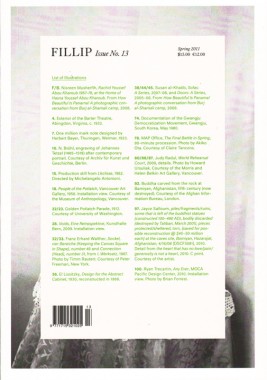
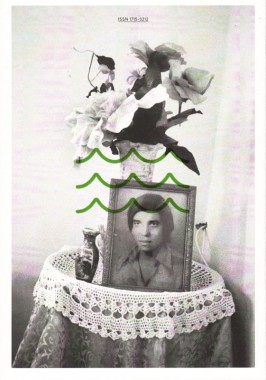
fillip 13, Intangible Economies
Softcover, 116 pp., offset 4/1, 170 x 245 mm
Edition of 2000
ISSN 1715-3212
Published by Fillip
$15.00 ·
Fillip 13 introduces
Intangible Economies, a new, ongoing series broadening the notion of economy beyond its financial dimensions. The series focuses on the multifarious forms of exchange fuelled by affect and desire, speculatively investigating the fundamental role these affective transactions play in modes of representation and, accordingly, in cultural production.
This issue includes series texts by Candice Hopkins, Jan Verwoert, and series editor Antonia Hirsch. Forthcoming installments will include contributions by Hadley+Maxwell, Olaf Nicolai, and Monika Szewczyk, among others.
The issue also features a record of The AAAARG Library, a site-specific installation commissioned for Fillip 13 and the 2010 NY Art Book Fair. The Library, produced by artist Sean Dockray and curated by Jeff Khonsary, will be presented again this summer as part of Night Market, a Red76 project for the Massachusetts Museum of Contemporary Art in North Adams, MA.
AAAARG Library, Anthony Downey, Antonia Hirsch, Art, Candice Hopkins, Carson Chan, Claire Tancons, Criticism, Distribution, Fillip, Hadley+Maxwell, Haema Sivanesan, Jan Verwoert, Jeff Khonsary, Jesse McKee, Kristina Lee Podesva, Lisa Marshall, Massachusetts Museum of Contemporary Art, Monika Szewczyk, Olaf Nicolai, Red76, Ryan Trecartin, Sean Dockray, Theory
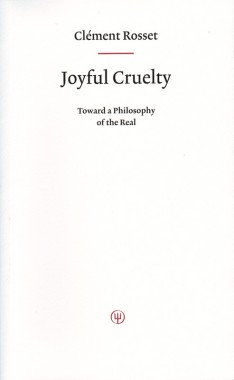
Clément Rosset, Joyful Cruelty: Toward a Philosophy of the Real
Softcover, 160 pp., offset 2/2, 5 x 8 inches
Edition of 1000
ISBN 978-0-9796121-1-4
Published by Free Association
$25.00 ·
This classic collection of essays by French philosopher and essayist Clément Rosset follows another Free Association title in the same format, Werner Herzog’s travel journal, Of Walking on Ice. The publisher is dedicated to finding worthy essays and other texts that have either been out of print or were never made available in English — especially seeking out works that have remained popular, at least among a small, devoted group, over the years. This work, out of print for 20 years, is the first and only work by the Paris-based Rosset (born 1939) to be translated into English. Rosset has written some 30 short books, many of which reference his important influence, Schopenhauer. “Joy is the necessary condition,” writes Rosset, “if not of life in general at least of life lived consciously and with full awareness.”
Clement Rosset, Free Association, Harsh Patel, RAM, Theory
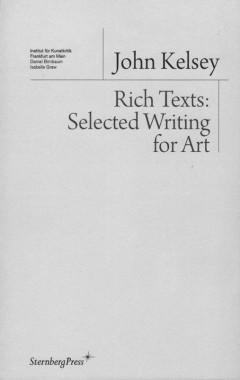
John Kelsey, Rich Texts: Selected Writing for Art
Softcover, 248 pp., offset 2/1, 120 x 190 mm
Edition of 2000
ISBN 978-1-934105-23-8
Published by Sternberg Press
$20.00 · out of stock
Compiled for the first time here, essays by American critic, artist, gallerist and dealer John Kelsey convey some of the most poignant challenges in the art world and in the many social roles it creates. “When the critic chooses to become a smuggler, a hack, a cook, or an artist,” Kelsey said, “it’s maybe because criticism as such remains tied to an outmoded social relation.” Kelsey’s “rich texts” play the double role of explaining the art world and actively participating in it; they close the distance between the work of art and how we talk about it. These playful, elegant writings — many originally published in Artforum — embody a timelessness that strikes at the core of the contemporary art world. The newest edition from the terrific Institut fur Kunstkritik series.
Criticism, Daniel Birnbaum, Isabelle Graw, John Kelsey, Markus Weisbeck, Matthew Evans, Miriam Rech, RAM, Sternberg Press, Theory
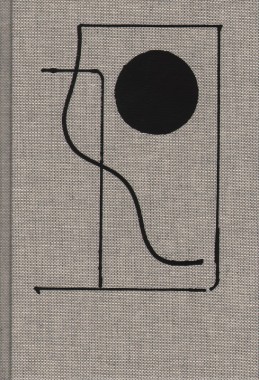
Boris Groys and Andro Wekua, Wait to Wait
Hardcover, 160 pp., offset 4/1, 135 x 196 mm
English and German
Edition of 2000
ISBN 978-3-03764-021-0
Published by JRP|Ringier, CK editions
$28.00 ·
An
unequal pair from the ranks of philosophy and contemporary art were brought to the table for debate. The celebrated Russian philosopher Boris Groys, and the young international artist from Georgia Andro Wekua, discussed their shared experiences in the Soviet system, the conditions governing production in contemporary art today, and the sensitivities of a generation of artists born in the 1970s, taking Wekua’s two large installations
Wait to Wait and
Get Out of My Room as examples.
Phenomena such as loneliness, doubles, repetitions, mirror images, and waiting are the central themes of this conversation, illustrated by pictures of the two installations and several collages by Wekua.
Andro Wekua, Art, Boris Groys, Christoph Keller, CK editions, Criticism, DAP, Galerie Peter Kilchmann, Gladstone Gallery, Interviews, JRP|Ringier, Philosophy, Theory
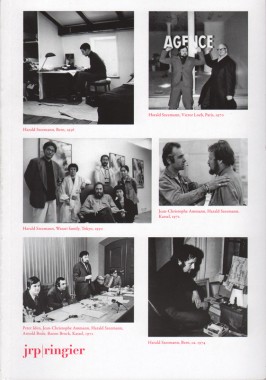
Harald Szeemann, Individual Methodology
Softcover, 240 pp., offset 2/1, 160 x 230 mm
Edition of 2000
ISBN 9783905829099
Published by JRP|Ringier
$25.00 ·
We owe our idea of the contemporary exhibition to Harald Szeemann — the first of the jet-setting international curators. From 1961 to 1969, he was Curator of the Kunsthalle Bern, where in 1968 he had the foresight to give Christo and Jeanne-Claude the opportunity to wrap the entire museum building. Szeemann’s groundbreaking 1969 exhibition When Attitudes Become Form, also at the Kunsthalle, introduced European audiences to artists like Joseph Beuys, Eva Hesse, Richard Serra and Lawrence Weiner. It also introduced the now-commonplace practice of curating an exhibition around a theme. Since Szeemann’s death in 2005, there has been research underway at his archive in Tessin, Switzerland. An invaluable resource, this volume provides access to previously unpublished plans, documents and photographs from the archive, along with important essays by Hal Foster and Jean-Marc Poinsot. There is also an informative interview with Tobia Bezzola — curator at the Kunsthauz Zurich and Szeemann’s collaborator for many years. Two of Szeemann’s most ambitious exhibitions are presented as case studies: Documenta V (1972) and L’Autre, the 4th Lyon Biennial (1997). A biography, an illustrated chronology of Szeemann’s exhibitions and a selection of his writings complete this exhaustive survey.
Art, Criticism, DAP, Florence Derieux, Hal Foster, Harald Szeemann, Jean-Marc Poinsot, JRP|Ringier, Theory, Tobia Bezzola
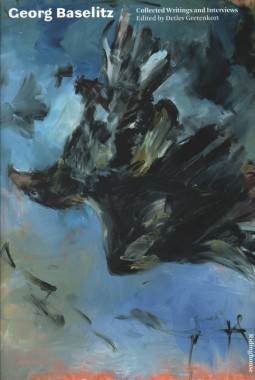
Detlev Gretenkort and Karsten Schubert, Georg Baselitz: Collected Writings and Interviews
Softcover, 300 pp., offset 4/1, 145 x 215 mm
Edition of 2000
ISBN 978-1-905464-23-4
Published by Ridinghouse
$49.00 ·
The outstanding British publisher Ridinghouse brings out the most comprehensive look into the life and work of German abstract expressionist Georg Baselitz. The book is divided into four sections: personal images; a record of Baselitz’s artworks; the artist’s own writings (some published for the first time, many never before translated into English); and interviews with the artist by noted writers and art historians. Known for his rebellious approach to painting, Baselitz discusses the act of painting, his biography and much more. The artist’s writings cover topics from his first trip abroad to other painters he’s admired. Though not a catalogue raisonné, this copiously illustrated book gives the most complete picture ever of a seminal artist.
Art, Criticism, Detlev Gretenkort, Fiona Elliott, Georg Baselitz, Interviews, Jill Lloyd, Karsten Schubert, Louisa Green, Mark Thomson, RAM, Ridinghouse, Theory, Writings
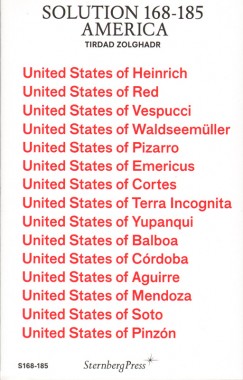
Tirdad Zolghadr, Solution 168-185: America
Softcover, 112 pp., offset 2/1, 110 x 180 mm
Edition of 2000
ISBN 978-1-933128-90-0
Published by Sternberg Press
$19.00 ·
Solution 168–185: America is the fourth book in the Solution series. Opting for the United States of America, “still the most proficiently colonial place I know,” Zolghadr provides a compilation of highly entertaining “solutions,” where the objective is not the education of America so much as the pleasure of a text that purports to be just that. Tirdad Zolghadr is a writer/curator based in Berlin. He is editor-at-large for Cabinet magazine. He organized the United Arab Emirates pavilion, Venice Biennale 2009, and the long-term project Lapdogs of the Bourgeoisie (with Nav Haq). Zolghadr teaches at the Center for Curatorial Studies, Bard College.
Art, Criticism, Ingo Niermann, Kari Rittenbach, Matthew Evans, RAM, Solution, Sternberg Press, Theory, Tirdad Zolghadr, Zak Kyes

































